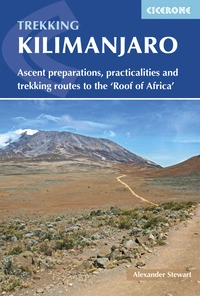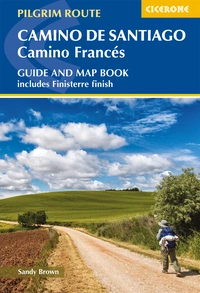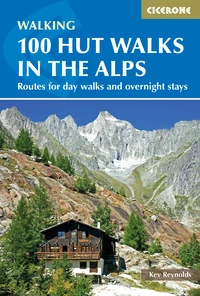Choosing a route to climb Kilimanjaro
There are six ways of getting to the summit of Kilimanjaro, but which of the routes up the mountain is best for you? Alex Stewart gives an overview of the options.
An aerial view of Kilimanjaro reveals a tangle of paths snaking across the slopes of the mountain. These paths are interconnected and in the course of a complete climb you will use an ascent route, a summit ascent route and a descent path.
In total, there are six ascent paths that climb across the lower slopes. Working your way clockwise around the mountain from the east, these are the Marangu Route, Umbwe Route, Machame Route, Lemosho Route, Shira Route and Rongai Route. At around 4000m, these paths all intersect with a circular path known variously as the Southern or Northern Circuit Path, depending on which side of the mountain you are on. You are then faced with three ascent paths to the summit – the Normal/Marangu Route, Barafu Route and Western Breach Route.
Each of these routes varies in terms of length, difficulty, what you will see along the way and, of course, cost. Regardless, each one will reward you with stunning panoramas and an incredible variety of scenic wonders. Read on to discover the best route for you to summit Kilimanjaro.

Marangu: "the Coca-Cola Route"
Length: 70km
Minimum number of days: Five
Pros: Historically nicknamed the Coca-Cola Route, Marangu is traditionally held to be one of the more straightforward routes on Kilimanjaro. It’s the only route where climbers stay in huts during the ascent. It is typically the cheapest route as it is shorter and you need less equipment and fewer porters. There are amazing views over the Saddle to both Kibo and Kilimanjaro’s second summit, Mount Mawenzi.
Cons: It can get very busy, especially at the huts. Surprisingly, a small percentage, some 40%, make it to the summit, usually because of the rapid ascent and inability to acclimatise properly. You have to retrace your steps and descend the way that you went up.
Why choose this route: If you can’t bear the thought of camping or are on a tight budget.
Umbwe: "the shortest and least-used route on the mountain"
Length: 48.5km
Minimum number of days: Five
Pros: The shortest and least-used route on the mountain. There are incredible forest sections where the woodland is scattered with pretty Impatiens kilimanjari flowers and exceptional views of the mountain, Barranco Valley and Southern Icefields. It has better summit success than Marangu, although this is skewed by the fact that typically only more experienced climbers ascend this way.
Cons: Considered the hardest ascent route, with some very steep sections and plenty of scrambling. Its short length means there’s less time for acclimatisation along the ascent.
Why choose this route: For a quieter experience, some of the most dramatic views of Kilimanjaro and unprecedented bragging rights.
Machame: "the busiest ascent route on Kilimanjaro"
Length: 61km
Minimum number of days: Six
Pros: The route winds through a spectacular range of scenery, with great views of Kilimanjaro as you traverse its flank from west to south. Traditionally, it has a high percentage success rate but as it has grown in popularity to become the single most used climb on Kilimanjaro, this has dropped.
Cons: In contrast to the Marangu Route, it is dubbed the Whiskey Route as it is held to be harder and more intoxicating. It is also more expensive. It is now the busiest ascent route on the mountain so is no longer quite the wilderness experience it once was.
Why choose this route: For amazing views and good odds of making the summit.
Shira: "less time for acclimatisation"
Length: 58km
Minimum number of days: Six
Pros: Not many people use this route so potentially there is more wildlife along the way, although you are still unlikely to see the buffalo and elephant that are present. There are interesting geological features on the Shira Plateau.
Cons: The start of the route is a long drive from Arusha or Moshi and you may be dropped high on the mountain having driven to altitude, giving you less time for acclimatisation and negatively affecting your chances of then making the summit.
Why choose this route: For the chance to climb a quieter side of the mountain, although the path intersects with the busier Machame Route to circumnavigate the South Circuit Path.
Lemosho: "explores a quieter side of the mountain"
Length: 67.5km
Minimum number of days: Seven
Pros: A longer, less-frequented route that explores a quieter side of the mountain. There is more time for acclimatisation as you ascend through an interesting forest section, with the opportunity to spot game and birdlife. There are great views and well-spaced campsites, plus the chance to combine the climb with a route around the rarely-used Northern Circuit Path to see an often-overlooked side of Kibo.
Cons: Because it is longer, it is more expensive. The first day involves a long drive to access the trailhead.
Why choose this route: To see the forest and fascinating Shira Plateau, acclimatise properly and boost your chance of making the summit.
Rongai: "the only route from the Kenyan side of Kilimanjaro"
Length: 74km
Minimum number of days: Six
Pros: The only route to ascend from the northern, Kenyan side of Kilimanjaro, with great views out over the savannah. There is a stunning campsite beneath the fractured cliff faces of Mawenzi and a haunting crossing of the Saddle to arrive at the base of Kibo.
Cons: The start of the trek is a long drive from Moshi and Arusha and some of the initial scenery is disappointing as the forest has been cut down. Descent is via the Marangu Route, although you camp instead of using the huts along the way, so the overnight stop on the way down can be busy.
Why choose this route: For an alternative view of the mountain and the best chance to explore Kilimanjaro’s second summit.
Summit routes
The six ascent routes all follow one of three summit paths to reach the crater rim on Kibo and, ultimately, Uhuru Peak. Which way you ascend will largely be dictated by the path you pick through the forest and lower elevations. Regardless, though, you will most likely be woken around midnight to start trekking in the dark. This means that you have time to get up to the summit as the sun rises and be back down to a lower elevation in one mammoth day – note, too, that not only will you descend to the foot of Kibo, you will continue down the mountain to an overnight camp at a much lower altitude.
Normal/Marangu: "the most straightforward"
Accessed from: Marangu and Rongai Routes
Time taken to summit: Six to eight hours
Altitude gain: 1185m
What’s it like? Potentially the most straightforward of the ascents, this is still a serious slog up Kibo’s eastern side on enervating scree slopes. You pass Hans Meyer Cave, named after the man who completed the first ascent, around the halfway point in terms of time, before beginning a series of agonising switchbacks. Exposed to the wind, you shuffle upwards before you break the crater rim at Gilman’s Point (5681m). It’s then a mental battle to haul yourself up the remaining 200 vertical metres, which are much gentler but take a further two hours.
Barafu: "unrelentingly steep"
Accessed from: Umbwe, Machame, Shira and Lemosho Routes
Time taken to summit: Six to eight hours
Altitude gain: 1235m
What’s it like? Tough. And monotonous. You need to stay motivated on scree slopes that suck you back down even as you try to climb up. The final half hour’s trudge up to Stella Point (5700m), where the Barafu Route crests the crater rim, is unrelentingly steep. However, upon arrival at Stella Point, you are much closer to your final goal and the trek round the crater rim and final climb to Uhuru Peak are both more straightforward and shorter, taking less than an hour to complete as the sun bursts across the horizon behind you.
Western Breach: "the hardest way"
Accessed from: Umbwe, Machame, Shira and Lemosho Routes
Time taken to summit: Five to six hours
Altitude gain: 1025m
What’s it like? This is the hardest way to reach Kilimanjaro’s summit. It is also potentially the most dangerous, with the risk of rockfall, particularly in one section, a serious consideration. Starting from Arrow Glacier Camp after a short climb the previous day from Lava Tower, you toil up scree slopes as another approaches. However, as the gradient gets steeper, you need to use your hands to scramble up the Breach Wall. A trance-like trudge will see you to the top of the two traditional summit paths but here you need to concentrate hard. After four or five hours’ tough graft, you enter the crater, from where it’s a further two hours to first cross the floor of the crater and then climb the inside of the rim on a series of tight zigzags before you reach the summit. The pay-off? Fabulous views, the chance to stand in the crater, the most exciting ascent and relatively few fellow climbers.













